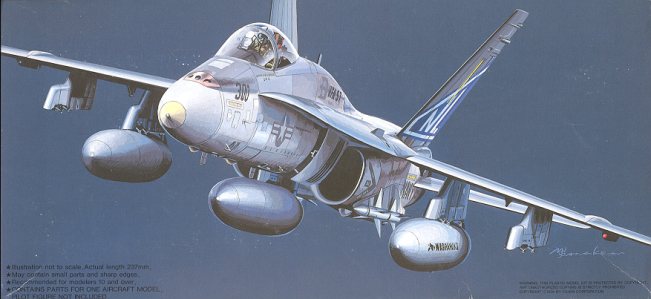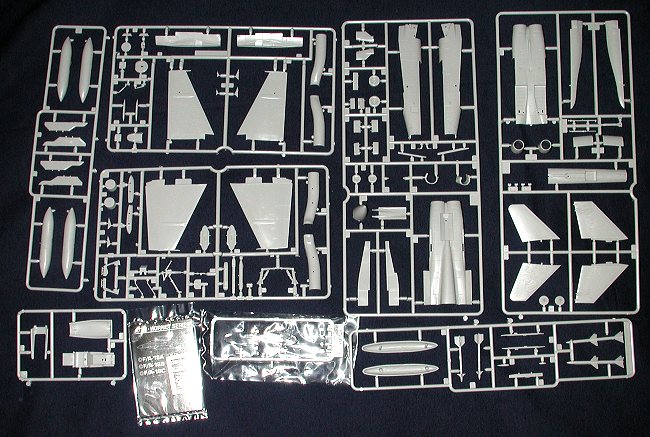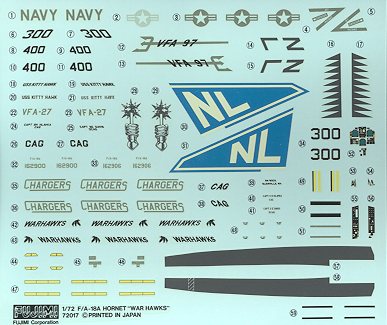
| KIT: | Fujimi 1/72 F-18A Hornet |
| KIT # | 72107 |
| PRICE: | $More than you'd think |
| DECALS: | Two Aircraft: See review |
| REVIEW & | |
| NOTES: | Includes small etched fret |

| HISTORY |
Starting back in the later days of WWII, it was seen that it wasquite possible to combine a fighter and an attack aircraft into one airframe.This was proven by the P-47 and the F4U, both of which performed those twofunctions equally as well. Somehow, that premise was not followed through andfor the next thirty years. It soon developed, at least as far as the Navy wasconcerned, that there were distinct communities that operated onlyfighter/interceptor aircraft, and those the operated attack aircraft. This wasdespite the fact that several fighters operated very well as attack aircraft,the F-4 Phantom II being a prime example. Not only was it a good interceptor,but it could carry a heft bomb load as well.
When developing the standards for a new fleet fighter in themid-1970s, it was decided that this aircraft would be a true multi-roleaircraft. Thus planning was underway for a new VFAX aircraft. However, Congressreared its ugly head and told the Navy that it would have to select one of thetwo aircraft undergoing the USAF lightweight fighter competition; the YF-16 orYF-17. Not wanting a single engined aircraft, the Navy chose the YF-17 andproceeded to develop it to meet Navy requirements. The result was so differentfrom the YF-17 that it was designated F-18.
Originally the Navy planned on three versions. A fighter F-18,an attack A-18A, and a trainer TF-18A (later redesignated F-18B). Since the Fand A-18 were so similar, it was decided to combine the aircraft into theF/A-18. Frankly, most of us just call it an F-18 though it is marked on the rearfuselage as an F/A-18. The aircraft was to have all the latest bells andwhistles including fly by wire, HOTAS (hands on throttles and stick, Heads updisplays and CRTs in place of several instruments.
Initial flight of the prototype was on 18 Nov 1978 at LambertField, St. Louis. There were nine single seat and two twin seat developmentaircraft, some of which are still in use. Despite all efforts, the F/A-18 cameup a bit short. It was not quite as good a fighter as was hoped and not quite asgood a bomber, either. It had a range 10-12 per cent shorter than the A-7 it wasto replace and could not carry the air to air weapons load of the F-4 or F-14.However, it was deemed to be good enough and was put into production.
The first Hornets entered the training squadron VFA-125 in late1980 with the first operational units being VMFA-323 and VMFA-314 at MCAS ElToro, who received their aircraft in early 1983. From there on, the aircraftsteadily replaced USMC F-4, A-4 and A-6 units as well as replacing A-7 and laterA-6 units in the USN. A few F-4 squadrons were also reactivated to fly theHornet. The Hornet is now in its third major upgrade with the F-18E/F being sentto training squadrons and will be with us for several decades to come.
| THE KIT |

Fujimi neverdoes things in a small way. The first thing you notice when opening the box arethe huge number of parts to this kit. I have built several Hasegawa Hornets, andthey have about half the pieces! Having said that, the Fujimi kit appears to bemuch better detailed, all of it engraved. For instance, it offers full intaketrunking that Hasegawa doesn't offer. It is also obvious that several variantscan be done using most of the same molds. The modular deal taking place here.Other niceties is the ability to have the boarding ladder open as well as anopen nose cone showing the radar and and open or closed speedbrake and cockpitcanopy. You also have the option of two wing mounted and one centerline droptank. Wingtip Sidewinders and fuselage mounted Sparrows are also given as arethe fuselage mounted seeker pods.
The kit includes a small etchedfret for the tail plane 'rub plates', the HUD mount and canopy mounted mirrors.The cockpit includes a four piece seat, though it looks a bit generic and youmay want to replace it with an aftermarket version. As with many kits in thisscale, the instruments are given as decals. Many of the parts have ejector pinmarks on them and some will be quite difficult to remove, including those insidegear doors and on the underside of the bomb racks. Thanks to the large number ofparts, construction will have to proceed carefully, especially the main fuselagewhich is made up of a number of sections. It will be fun to try to fill theseams in the long intake trunks. While I may have missed it, there are noLEREX's included with this kit. Those are the little fences on the upperfuselage designed to relieve aerodynamic stress from the rudders. If that is thecase, then you will be unable to use the kit decals and have to use aftermarketones for an earlier plane. Or you could make them from small bits of sheetstyrene.
I nstructionsare very good giving ten construction steps. Color callouts using Gunze paintsare given for all steps. The decal sheet offers two aircraft, one from VFA-97and another from VFA-27. These two squadrons from the Kitty Hawk before she wentto Japan, were the last two to fly the F-18A in Fleet service. Decals are quitecomplete and though for CAG birds are not that colorful as CAG birds were in thepast. If using the kit decals, make sure that you use warm water to get them offthe backing sheet and do not use any setting solution on them. The warm watermakes them pliable enough to snuggle down nicely.
nstructionsare very good giving ten construction steps. Color callouts using Gunze paintsare given for all steps. The decal sheet offers two aircraft, one from VFA-97and another from VFA-27. These two squadrons from the Kitty Hawk before she wentto Japan, were the last two to fly the F-18A in Fleet service. Decals are quitecomplete and though for CAG birds are not that colorful as CAG birds were in thepast. If using the kit decals, make sure that you use warm water to get them offthe backing sheet and do not use any setting solution on them. The warm watermakes them pliable enough to snuggle down nicely.
It looks as ifit will build into a nice kit. However, because of the plethora of small partsand what appears to be a rather fiddly construction design, I can't recommendthis to new modelers.
| REFERENCES |
McDonnell-Douglas Aircraft since 1920, by Rene Francillon,1990, Naval Institute Press, ISBN 1-55750-550-0
Review kit courtesy of me and my wallet!
If you would like your product reviewed fairly and quickly by asite that has over 1,500 visits a day, please contactme or see other details in the